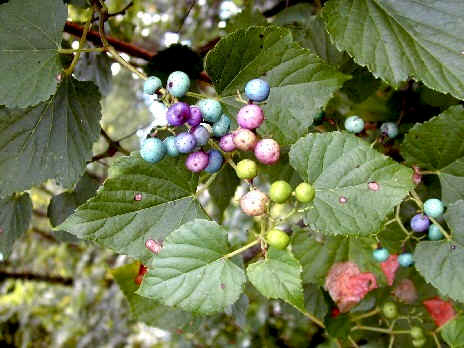| Ampelopsis brevipedunculata | |
|
Porcelain-Berry
|
|
| Origin Of Species | |
| China, Korea, Japan, Eastern Russia | |
| Physical Description | |
| Porcelain-berry is a deciduous perennial vine that grows between fifteen and twenty feet in height. It possesses simple, dark green, heart-shaped leaves with toothed edges, which may be lobed or dissected. Porcelain-berry leaves are arranged in an alternating formation along the vines. Tendrils appear opposite the leaves and aid in climbing. Small, greenish flowers appear in clusters between June and August. The most distinguishing features of the porcelain-berry vine are the colorful berries, which appear between September and October. | |
| Habitat And Distribution | |
| Porcelain-berry is prominent in open areas of urban landscapes, especially near parks with wooded borders. It is found primarily in the northeastern corner of the United States, but extends as far south as North Carolina and west to Michigan. | |
| Location On Campus | |
| Porcelain-berry is abundant near the Westhampton tennis courts, along the border of the intramural fields, and surrounding the ravine between Jepson Hall and Richmond Way. | |
| Negative Impacts | |
|
Porcelain-berry is often an ornamental that spreads to other areas because of its ability to survive in a variety of habitats. While porcelain-berry is often slow to establish, it grows and spreads quickly, often into areas of disturbance. The resilient vine can destroy native vegetation by shading out smaller plants and out-competing for water and nutrients. |
|
| VDCR Invasiveness Ranking | |
| Highly Invasive Species Additional Images: Berries with leaves Flowers with leaves |
|
